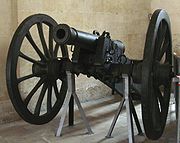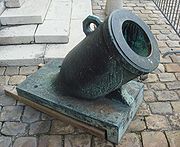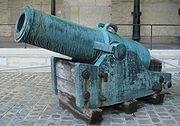
Year XI system
Encyclopedia


Napoleon I
Napoleon Bonaparte was a French military and political leader during the latter stages of the French Revolution.As Napoleon I, he was Emperor of the French from 1804 to 1815...
. The Year XI system was original in that it brought various improvements to the highly successful Gribeauval system
Gribeauval system
The Gribeauval system was an artillery system introduced by Lieutenant General Jean Baptiste Vaquette de Gribeauval during the 18th century. This system revolutionized French cannon, with a new production system that allowed lighter, more uniform guns without sacrificing range. The Gribeauval...
, on which many successes of the Napoleonic Wars
Napoleonic Wars
The Napoleonic Wars were a series of wars declared against Napoleon's French Empire by opposing coalitions that ran from 1803 to 1815. As a continuation of the wars sparked by the French Revolution of 1789, they revolutionised European armies and played out on an unprecedented scale, mainly due to...
relied. It especially consisted in streamlining the existing Gribeauval designs. The main proponent of the new system was General Marmont.
Definition
In light of the Revolutionary WarsRevolutionary Wars
Revolutionary Wars may relate to:*American Revolutionary War*French Revolutionary Wars...
it appeared especially that the Gribeauval 4-pdr was too light, and that the 8-pdr was too heavy for medium field artillery. These two guns had not appeared adequate against enemy 6-pdr guns.
In order to define the new improved system, Napoleon formed a committee of Artillery on 29 December 1801, presided by general Augustin Gabriel d'Aboville, First Inspector of Artillery. The committee accomplished its research from 11 January 1802 to 21 July 1802. Napoleon himself participated to the proceedings:
The committee gave its results on 2 May 1803.

- To recommend the introduction of a 6-pdr and the suppression of the 4-pdr and the 8-pdr.
- The field artillery would thus be composed of a 12-pdr cannon, a 6-pdr cannon and a 24-pdr (5.72-inch) howitzerHowitzerA howitzer is a type of artillery piece characterized by a relatively short barrel and the use of comparatively small propellant charges to propel projectiles at relatively high trajectories, with a steep angle of descent...
- The mountain artillery would have the short 3-pdr cannon, short 6-pdr cannon and 24-pdr howitzer.
- Siege artillery was also modified, with the introduction of new Long 24-pdr and Short 24-pdr,
- Garrison artillery was also modified, with the introduction of new Long 24-pdr, Long 12-pdr and Long 6-pdr cannons
- New Mortars as well as 324mm, 216mm and 152mm mortars, and 405mm perriers.
Obsolescence

Valée system
The Valée system was an artillery system developed between 1825 and 1831 by the French artillery officer Sylvain Charles Valée, and officially adopted by the French Army from 1828.-Specifications:...
in 1828.
References
- Dawson, A.L., Dawson P.L. and Summerfield S. (2007) Napoleonic Artillery, Crowood Press, ISBN 978-1-86126-9232
- Smith, Digby (trans) (2011) "The Austrian Cavalry Gun in Comparison to the Horse Artillery of Other States by Smola in 1827," Smoothbore Ordnance Journal, Issue 1, Ken Trotman Publishing, ISBN 978-1-907417-13-9

